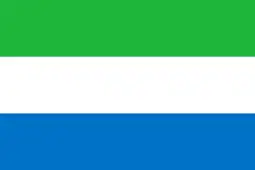Dominion of Sierra Leone | |||||||||
|---|---|---|---|---|---|---|---|---|---|
| 1961–1971 | |||||||||
| Motto: Unity, Freedom, Justice | |||||||||
| Anthem: High We Exalt Thee, Realm of the Free | |||||||||
.svg.png.webp) | |||||||||
| Capital | Freetown | ||||||||
| Government | Unitary parliamentary constitutional monarchy | ||||||||
| Queen | |||||||||
• 1961–1971 | Elizabeth II | ||||||||
| Governor-General | |||||||||
• 1961–1971 | See list | ||||||||
| Prime Minister | |||||||||
• 1961–1971 | See list | ||||||||
| Historical era | Decolonisation of Africa | ||||||||
• Independence | 27 April 1961 | ||||||||
• Republic | 19 April 1971 | ||||||||
| Population | |||||||||
• 1963 | 2,180,355[1] | ||||||||
• 1965 | 2,473,294[2] | ||||||||
• 1970 | 2,692,259[2] | ||||||||
| Currency | British West African pound (1961–1964) Sierra Leonean Leone (1964–1971) | ||||||||
| |||||||||
| Today part of | Sierra Leone | ||||||||
The Dominion of Sierra Leone was an independent sovereign state with Queen Elizabeth II as its head of state between independence on 27 April 1961 and becoming the Republic of Sierra Leone on 19 April 1971.[3]
When British rule ended in April 1961, the British Crown Colony of Sierra Leone was given independence under the Sierra Leone Independence Act 1961.[4] Elizabeth II, remained the head of state of Sierra Leone[5] and was represented in Sierra Leone by a Governor-General.[6] Sierra Leone shared the Sovereign with other countries, including the United Kingdom.
History
On 27 April 1961, Sierra Leone gained independence.[7]
In 1962, general elections were won by the Sierra Leone People's Party (SLPP). The All People's Congress (APC) emerged as the most organised opposition.[7]
In March 1964, Njala University opened. On 28 April 1964, Prime Minister Sir Milton Margai died. His brother, Sir Albert Margai, was appointed as the new prime minister. On 4 August 1964, Sierra Leone's decimal currency, the Sierra Leonean leone, was introduced to replace the British West African pound.[8]
In 1967, general elections were held in Sierra Leone. The APC won by a narrow margin. Brigadier John Lansana, head of the military, seized control of government immediately after swearing in of the new APC prime minister, Siaka Stevens. Lansana was ousted a few days later by junior military officers who invited Andrew Juxon-Smith, a senior officer on leave, to return and head a provisional government, the National Reformation Council (NRC).[8]
In 1968, the NRC was overthrown by warrant officers of the army. John Bangura, a formerly dismissed senior officer, invited to head the army. Bangura turned over government to the APC, led by Siaka Stevens.[8]
In 1969, the University of Sierra Leone was set up, comprising Fourah Bay College and Njala University.[8]
On 19 April 1971, Sierra Leone became a republic with Siaka Stevens as the first executive President of the Republic.[8]
Governors-General
The Governors-General of Sierra Leone were:[3]
- Sir Maurice Henry Dorman (27 April 1961 – 27 April 1962)
- Sir Henry Josiah Lightfoot Boston (27 April 1962 – April 1967)
- Andrew Juxon-Smith (April 1967 – 18 April 1968) (acting)
- John Amadu Bangura (18–22 April 1968) (acting)
- Sir Banja Tejan-Sie (22 April 1968 – 31 March 1971)
- Christopher Okoro Cole (Chief Justice of Sierra Leone) (31 March – 19 April 1971) (interim)
Prime Ministers
The Prime Ministers (and heads of government) of Sierra Leone during this period were:[3]
- Sir Milton Margai (27 April 1961 – 30 April 1964) (died in office)
- Sir Albert Margai (30 April 1964 – 17 March 1967)
- Siaka Stevens (first term) (17 March 1967 – 21 March 1967)
- David Lansana (21 March 1967 – 24 March 1967)
- Ambrose Patrick Genda (24 March 1967 – 27 March 1967)a
- Andrew Juxon Smith (27 March 1967 – 19 April 1968)a
- Patrick Conteh (19 April 1968 – 26 April 1968)b
- Siaka Stevens (second term) (26 April 1968 – 19 April 1971)
a. As Chairman of the National Reform Council.
b. As Chairman of the National Interim Council.
Transition to a Republic
.svg.png.webp)
Queen Elizabeth II visited Sierra Leone from 25 November to 1 December 1961, shortly after independence.[9]
Sierra Leone became a republic within the Commonwealth on the promulgation of the 1971 Constitution of Sierra Leone and Prime Minister Siaka Stevens became the first President of Sierra Leone.[10]
See also
References
Bibliography
- Kargbo, Michael S. (2006). British Foreign Policy and the Conflict in Sierra Leone, 1991–2001. Peter Lang. p. 70.
- Fyle, Magbaily C. (2006). Historical Dictionary of Sierra Leone. Lanham, Maryland: Scarecrow Press. pp. XVII–XXII. ISBN 978-0-8108-5339-3.
Notes
- ↑ "FINAL RESULTS 2004 POPULATION AND HOUSING CENSUS" (PDF). Sierra-leone.org. Retrieved 15 August 2018.
- 1 2 "Sierra Leone Population". Worldometers. Retrieved 3 January 2018.
- 1 2 3 "Sierra Leone". WorldStatesmen.org. Retrieved 19 November 2017.
- ↑ "Sierra Leone Independence Act 1961". Legislation.gov.uk. Retrieved 19 November 2017.
- ↑ "Sierra Leone Heads". Worldwide Guide to Women in Leadership. Retrieved 20 November 2017.
- ↑ Kargbo 2006, p. 70.
- 1 2 Fyle 2006, p. XXII.
- 1 2 3 4 5 Fyle 2006, p. XXIII.
- ↑ "Commonwealth Tours: 1960s". British Pathé. Retrieved 20 November 2017.
- ↑ "Sierra Leone". The Commonwealth. Retrieved 20 November 2017.
External links
- "SIERRA LEONE INDEPENDENCE BILL (Hansard, 27 March 1961)". Parliamentary Debates (Hansard). 27 March 1961. Retrieved 26 January 2017.
- "SIERRA LEONE (GIFT OF A MACE) (Hansard, 30 January 1962)". Parliamentary Debates (Hansard). 30 January 1962. Retrieved 26 January 2017.
- "Orders of the Day – Sierra Leone Independence Bill: 22 Mar 1961: House of Commons debates". TheyWorkForYou. Retrieved 26 January 2017.

